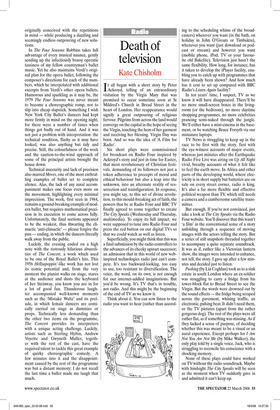Death of television
Kate Chisholm
It all began with a short story by Peter Ackroyd, telling of an extraordinary visitation by the Virgin Mary that was promised to occur sometime soon at St Mildred’s Church in Bread Street in the heart of London. Her reappearance would signify a great outpouring of religious fervour. Pilgrims from across the land would converge on the capital in the hope of seeing the Virgin, touching the hem of her garment and receiving her blessing. Virgin Day was born. And so was the idea of ‘A Film for Radio’.
Six short plays were commissioned for broadcast on Radio Four inspired by Ackroyd’s story and just in time for Easter, that most revolutionary of Christian festivals, demanding of its followers not just a token adherence to precepts of moral and ethical behaviour but also a leap into the unknown, into an alternate reality of resurrection and transfiguration. In response, you might say, to this act of divine revolution, to this mould-breaking act of faith, the powers that be at Radio Four and BBC TV finally agreed to come together to create The City Speaks (Wednesday and Thursday, multimedia). To enjoy its full impact, we were supposed to tune into Radio Four and press the red button on our digital TVs so that we could watch as well as listen.
Superficially, you might think that this was a final submission by the radio controllers to the advances of its cheeky upstart successor; an admission that in this world of new webinspired technologies radio just can’t compete. It’s too backward-looking, too easy to use, too resistant to diversification. The voice, the word, on its own, is not enough for our internet-addled imaginations. But you’d be wrong. It’s TV that’s in trouble, not radio. And this might be the beginning of the end of TV as we know it.
Think about it. You can now listen to the radio you want to hear (rather than accord ing to the scheduling whims of the broadcasters) wherever you want (in the bath, on holiday in John O’Groats or Timbuktu), whenever you want (just download or podcast or stream) and however you want (mobile phone, iPod, TV or your favourite old Bakelite). Television just hasn’t the same flexibility. How long, for instance, has it taken to develop the iPlayer facility, enabling you to catch up with programmes that have already been shown? And how much has it cost to set up compared with BBC Radio’s Listen Again facility?
In ten years’ time, I suspect, TV as we know it will have disappeared. There’ll be no more small-screen boxes in the livingroom (or the bedroom), no more daytime shopping programmes, no more celebrities prancing semi-naked through the jungle. We’ll either have a mini-cinema in the basement, or be watching Bruce Forsyth via our miniature laptops.
TV News is struggling to keep up in the race to be first with the story, first with the eye-witness accounts of major events, whereas just minutes after the Earthquake Radio Five Live was airing on Up All Night vivid, breathy accounts of what it felt like to feel the earth move. In Africa and other parts of the developing world, where electricity is in short supply but batteries are on sale on every street corner, radio is king. It’s also a far more flexible and effective political weapon than TV, which still needs a camera and a cumbersome satellite transmitter.
But enough. If you’re not convinced, just take a look at The City Speaks via the Radio Four website. You’ll discover that this wasn’t ‘a film’ in the conventional sense of a story unfolding through a sequence of moving images with the actors telling the story. But a series of still snapshots threaded together to accompany a quite separate soundtrack. It was as if, rather like a Victorian lantern show, the images were intended to enhance, not tell, the story. I gave up after a few minutes and decided just to listen.
Pushing (by Lin Coghlan) took us to a sink estate in south London where an ex-soldier was struggling to carry a fridge from his tower-block flat to Bread Street to see the Virgin. But the words were drowned out by the sound effects — the fridge being scraped across the pavement, whining traffic, an electronic, pulsing beat. It didn’t need them, or the TV pictures (apart from the rather gorgeous dog). The rest of the plays were all rather flat, as if something was missing. As if they lacked a sense of purpose, of deciding whether this was meant to be a visual or an aural experience. Except perhaps for I Am Not You Are Not Me (by Mike Walker), the only play told by a single voice, Jack, who is struggling to reconcile his conscience with a shocking memory.
None of these plays could have worked on TV without the radio soundtrack. Maybe with hindsight The City Speaks will be seen as the moment when TV suddenly gave in and admitted it can’t keep up.


















































































 Previous page
Previous page